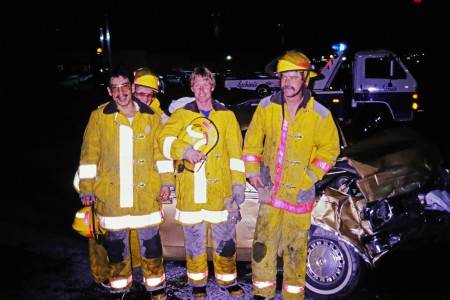TEAM CPR GUIDELINES (pit crew CPR)
ALL LEVELS
DESIGNATION OF CONDITION
CPR performed during cardiac arrest should be a coordinated effort to maximize patient outcomes and minimize compression interruptions.
EMPHASIS ON PATIENT CARE
Team approach improves CPR quality, reduces CPR pauses, and reduces confusion between providers. Metronome or similar device can help with CPR pace (≥100 compressions/minute) if available. Do not interrupt chest compressions to place airway device. If cardiac arrest due to primary respiratory cause initiate mask ventilation as soon as possible.
1. FIRST provider to patient:
a. Begin continuous compressions hard (≥2 in.) and fast (100/min.-120/min)
b. Recheck pulse every 2 minutes (<5 seconds for each check)
c. Place AED or cardiac monitor at first pulse check if still alone
d. Call for/update additional responders
2. SECOND Provider to patient:
a. Place AED or monitor if not already in place
b. Appropriate guideline based on rhythm
c. Place high flow oxygen via non-rebreather for first TWO cycles of high CPR
d. Take over compressions at next pulse check
e. Alternate compressions with first provider every two minutes until more help arrives
i. If no additional help place airway and apply ventilator after 4 minutes of CPR
3. THIRD Provider to patient:
a. Assumes or assigns "Code Command"
4. CODE COMMAND:
a. Enforces appropriate guideline based on rhythm
b. Ensures compressors are rotating at 2 minute intervals
c. Ensures CPR pauses are MINIMIZED
d. Apply ventilator if available
e. Assigns additional tasks according to appropriate guideline
f. Tracks/records code progress
g. Responsible for updating family and calling MCEP
5. ADDITIONAL providers to arrive:
a. Place IV or IO
b. Medications per appropriate guideline
c. Airway management w/ BVM, SGA/EGA, or ETT if paramedic. Consider use of pediatric BVM for ventilation of adult patients to avoid over ventilation.
d. Additional tasks as assigned
ALL LEVELS
DESIGNATION OF CONDITION
CPR performed during cardiac arrest should be a coordinated effort to maximize patient outcomes and minimize compression interruptions.
EMPHASIS ON PATIENT CARE
Team approach improves CPR quality, reduces CPR pauses, and reduces confusion between providers. Metronome or similar device can help with CPR pace (≥100 compressions/minute) if available. Do not interrupt chest compressions to place airway device. If cardiac arrest due to primary respiratory cause initiate mask ventilation as soon as possible.
1. FIRST provider to patient:
a. Begin continuous compressions hard (≥2 in.) and fast (100/min.-120/min)
b. Recheck pulse every 2 minutes (<5 seconds for each check)
c. Place AED or cardiac monitor at first pulse check if still alone
d. Call for/update additional responders
2. SECOND Provider to patient:
a. Place AED or monitor if not already in place
b. Appropriate guideline based on rhythm
c. Place high flow oxygen via non-rebreather for first TWO cycles of high CPR
d. Take over compressions at next pulse check
e. Alternate compressions with first provider every two minutes until more help arrives
i. If no additional help place airway and apply ventilator after 4 minutes of CPR
3. THIRD Provider to patient:
a. Assumes or assigns "Code Command"
4. CODE COMMAND:
a. Enforces appropriate guideline based on rhythm
b. Ensures compressors are rotating at 2 minute intervals
c. Ensures CPR pauses are MINIMIZED
d. Apply ventilator if available
e. Assigns additional tasks according to appropriate guideline
f. Tracks/records code progress
g. Responsible for updating family and calling MCEP
5. ADDITIONAL providers to arrive:
a. Place IV or IO
b. Medications per appropriate guideline
c. Airway management w/ BVM, SGA/EGA, or ETT if paramedic. Consider use of pediatric BVM for ventilation of adult patients to avoid over ventilation.
d. Additional tasks as assigned
